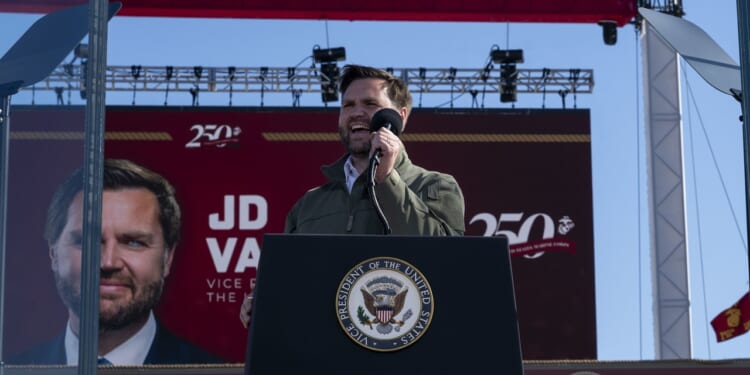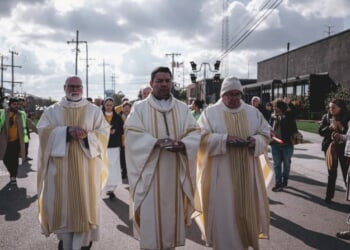A misfired artillery shell damaged a California Highway Patrol vehicle—raising concerns about what might have occurred if the highway near Camp Pendleton had not been closed for the celebration.
A California Highway Patrol (CHP) vehicle was hit by shrapnel while carrying out protection duties for Vice President JD Vance. The shrapnel was fired by a United States Marine Corps cannon—but it wasn’t part of a coup or assassination attempt against the vice president.
What to Know About the California Friendly Fire Incident
On Saturday, while Vance was attending the United Marine Corps’ 250th anniversary celebrations in the Golden State, an artillery shell fired during the celebration “prematurely detonated” over California’s Interstate 5 highway, striking a patrol car and at least one other vehicle that was part of Vance’s protection detail. CHP officers reported seeing an artillery found failing to clear the southbound lanes of the highway.
Multiple pieces of shrapnel were found after the celebration, including one large enough that it dented the hood of a patrol car assigned to the protection duties.
Vice President Vance served four years as a US Marine, including a tour of duty in Iraq. He has credited his time in uniform for his business and political successes.
“I would not be here today, I would not be the vice president of the United States, I would not be the man I am today were it not for those four years that I served in the Marine Corps,” Vance, the first vice president to serve in the Marines, said in remarks on Saturday.
No one was injured in the incident, which took place where the highway patrol had stopped all traffic for the live fire exercise. After the shrapnel hit the car, the Marine Corps ceased firing and canceled the live fire demonstration.
Governor Gavin Newsom Vindicated?
However, the damage was done and California Governor Gavin Newsom—a member of the Democratic Party and a longtime foil of Vance and President Donald Trump—was quick to criticize the firing of the ordnance.
“Firing live rounds over a busy highway isn’t just wrong – it’s dangerous,” Newsom said in a statement.
Ahead of the live-fire demonstration, Newsom had ordered the closure of Interstate 5, citing risks from the USMC event. The governor’s office expressed concerns about driver safety, including distractions from “sudden unexpected and loud explosions.” Such actions could lead to accidents, injuries, or even fatalities, underscoring the need for a thorough safety review.
Newsom’s critique set off a war of words, with Vance’s team firing back.
“If Gavin Newsom wants to oppose the training exercises that ensure our Armed Forces are the deadliest and most lethal fighting force in the world, then he can go right ahead,” William Martin, Vance’s communications director, said in a statement to CNN.
The California Highway Patrol also condemned the decision to carry out a live fire over a public highway, even one that was closed at the time to civilian traffic.
“This was an unusual and concerning situation,” explained California Highway Patrol Border Division Chief Tony Coronado in a statement to the media. “It is highly uncommon for any live-fire or explosive training activity to occur over an active freeway. As a Marine myself, I have tremendous respect for our military partners, but my foremost responsibility is ensuring the safety of the people of California and the officers who protect them.”
Why Did the Marines Fire over the I-5 Freeway?
The United States Marine Corps maintained that live-fire training occurs regularly at Camp Pendleton, and procedures are in place to ensure it is safely carried out. It is unclear why the decision was made to fire over the freeway.
Although civilian traffic was halted, there were still CHP patrol cars and other protection vehicles in the vicinity, including Vance’s motorcade.
“We are aware of the report of a possible airborne detonation of a 155mm artillery round outside the designated impact area during the U.S. Marine Corps Amphibious Capabilities Demonstration,” USMC spokesperson Capt. Gregory Dreibelbis told CNN on Sunday via another statement.
“The demonstration went through a rigorous safety evaluation, and deliberate layers of redundancy, to ensure the safety of fellow citizens,” Dreibelbis added. “Following established safety protocols, firing was suspended. No injuries occurred and the demonstration concluded as scheduled.”
It is unclear what type of round was fired, but demonstrations typically employ simulated explosives. These rounds feature the same dimensions, weight, and even ballistic characteristics of live ammunition, but with a practice warhead that is either less destructive or contains no explosive fill.
About the 155mm Artillery Round
The 155mm artillery round remains the standardized ordnance for NATO artillery. It evolved from the 155mm (6.1 in) caliber developed in France after the Franco-Prussian War (1870-71). It was refined during World War I and adopted by multiple NATO members during the Cold War. Each round weighs roughly 100 pounds (45 kg) and is about two feet (60 cm) in length and 6.1 inches (155 mm) in diameter, with the latter determining its modern caliber. This size and weight make it a powerful and potentially dangerous weapon, especially when fired over a populated area.
The artillery shell is produced in several configurations, including high explosive (HE), armor piercing (AP), smoke, and high fragmentation. There are also guidance systems for precision strikes that are meant to minimize collateral damage, extended range versions, and training rounds.
Since the onset of the Russian invasion of Ukraine in February 2022, millions of 155mm shells have been shipped to Ukraine for use by the Ukrainian Armed Forces. Russia uses the 155mm caliber as well.
About the Author: Peter Suciu
Peter Suciu has contributed over 3,200 published pieces to more than four dozen magazines and websites over a 30-year career in journalism. He regularly writes about military hardware, firearms history, cybersecurity, politics, and international affairs. Peter is also a contributing writer for Forbes and Clearance Jobs. He is based in Michigan. You can follow him on Twitter: @PeterSuciu. You can email the author: [email protected].
Image: Flickr / U.S. Secretary of War.

















